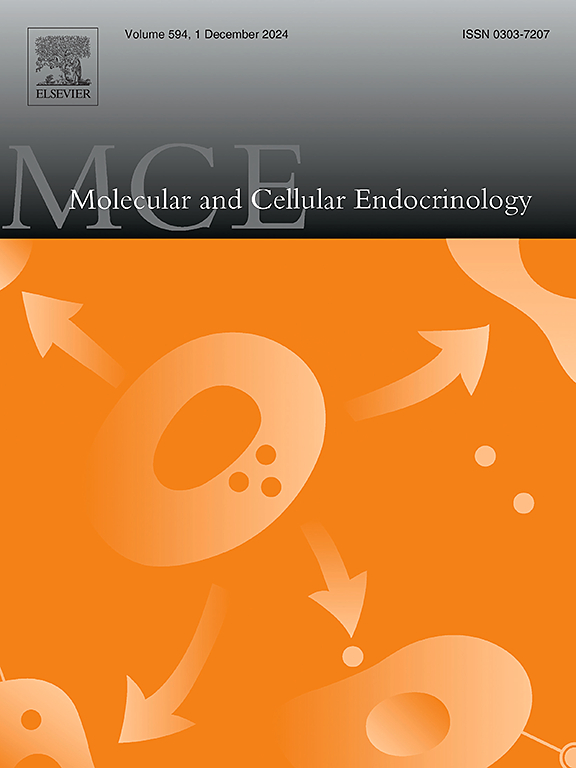妊娠前母体多巴胺激动剂治疗可通过哺乳逆转hcg过表达小鼠的不育和高泌乳素血症:代际效应的证据
IF 3.6
3区 医学
Q2 CELL BIOLOGY
引用次数: 0
摘要
卡贝戈林(Cabergoline,简称 Cab)等多巴胺受体激动剂在高催乳素血症和荷尔蒙失调的情况下具有恢复生殖功能的功效。本研究调查了母体卡麦角林治疗对因人绒毛膜促性腺激素(hCG)β亚基过度表达而导致高泌乳素血症和不育症的雌性转基因(TG)小鼠模型后代生殖表型的长期影响。在出生后第3-4周接受Cab治疗的TG雌鼠表现出高泌乳素血症和不育症的逆转,而WT雌鼠则保持了生育能力。当TG-cab或WT-Cab处理的雌性分别与WT或TG雄性杂交时,它们的雌性TG后代表现出性早熟逆转、发情周期规律化、生育能力以及高催乳素血症和催乳素瘤的预防。尽管 LH/hCG 生物活性持续较高,但催乳素水平的正常化导致卵巢黄体化标志物和孕酮水平下降。WT-cab或TG-cab处理过的雌鼠所生的TG雌鼠幼崽表现出正常化的表型,从而表明这些影响确实是母体Cab给药造成的,而不是转基因造成的。交叉寄养实验表明,母体 Cab 对后代的长效编程效应发生在哺乳期,因为未经 WT 雌性/TG 雄性处理但由 Cab 处理的雌性哺乳的 TG 雌性幼仔没有改变 TG 表型。这些结果表明,妊娠前的 Cab 治疗可能会对后代的下丘脑-垂体-性腺轴产生多代效应,并在哺乳期发挥介导作用。这凸显了在哺乳期使用多巴胺激动剂对代际健康和临床实践的潜在影响。本文章由计算机程序翻译,如有差异,请以英文原文为准。

Maternal dopamine agonist treatment before pregnancy reverses infertility and hyperprolactinemia in hCG-overexpressing mice through lactation: Evidence of generational effects
Dopamine agonists, such as cabergoline (Cab), have demonstrated efficacy in restoring reproductive function in cases of hyperprolactinemia and hormonal dysregulation. This study investigates the long-term consequences of maternal Cab treatment on the reproductive phenotype of the progeny in a female transgenic (TG) mouse model with hyperprolactinemia and infertility due to human chorionic gonadotropin (hCG) β-subunit overexpression. The TG females that received Cab between weeks 3–4 of life exhibited a reversion of hyperprolactinemia and infertility, whereas WT females retained their fertility. When TG-cab- or WT-Cab-treated females were crossed with WT or TG males, respectively, their female TG offspring showed a reversal of precocious puberty, regularization of estrous cycles, fertility, and prevention of hyperprolactinemia and prolactinomas. Despite the persistent high LH/hCG bioactivity, the normalization of prolactin levels led to a reduction in ovarian luteinization markers and progesterone levels. The TG female pups born to either WT-cab- or TG-cab-treated females exhibited a normalized phenotype, thus suggesting that the effects were indeed due to maternal Cab administration, and not to the transgene. Cross-fostering experiments showed that the long-lasting programming effect of maternal Cab on offspring occurred during lactation because the TG female pups from non-treated WT female/TG male pregnancies, but nursed by Cab-treated females, were free from the altered TG phenotype. These results suggest that Cab treatment before pregnancy may have a multigenerational effect on the hypothalamic-pituitary-gonadal axis of the offspring, mediated during lactation. This highlights potential implications for generational health and clinical practices regarding the use of dopamine agonists during lactation.
求助全文
通过发布文献求助,成功后即可免费获取论文全文。
去求助
来源期刊

Molecular and Cellular Endocrinology
医学-内分泌学与代谢
CiteScore
9.00
自引率
2.40%
发文量
174
审稿时长
42 days
期刊介绍:
Molecular and Cellular Endocrinology was established in 1974 to meet the demand for integrated publication on all aspects related to the genetic and biochemical effects, synthesis and secretions of extracellular signals (hormones, neurotransmitters, etc.) and to the understanding of cellular regulatory mechanisms involved in hormonal control.
 求助内容:
求助内容: 应助结果提醒方式:
应助结果提醒方式:


